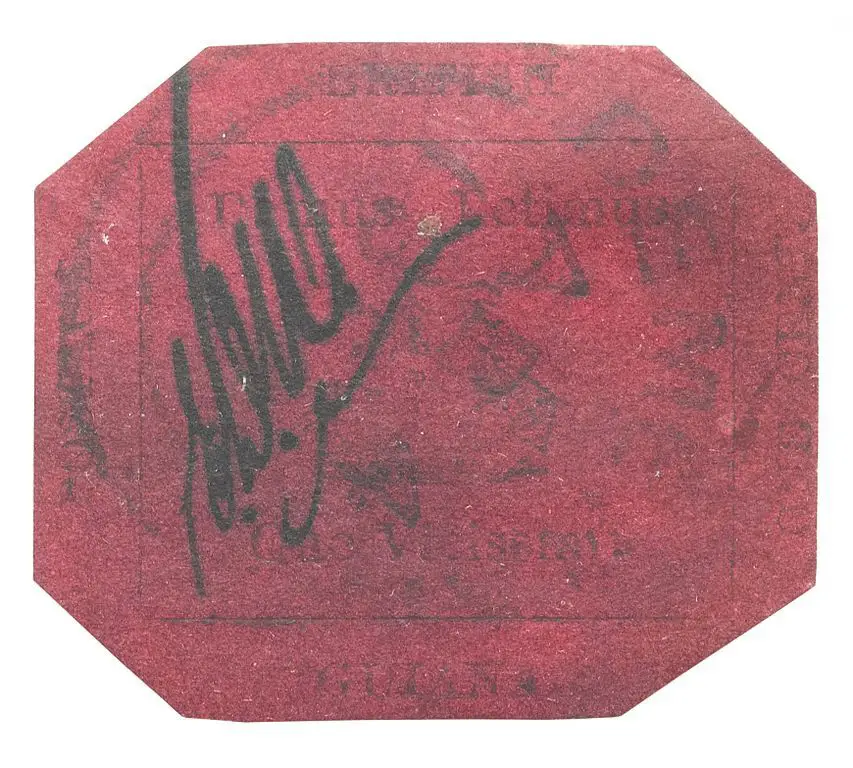
The most expensive stamp in the world is the 1856 British Guiana One-Cent Magenta. It is also considered the rarest. It sold at auction in 2014 for $9.5 million. What makes this tiny piece so rare and expensive? It has to do with the history behind it and how it is the only one of its kind.
The story of the magenta-colored one-cent stamp in the shape of an octagon started in 1855 in British Guiana, a colony of Great Britain in northern South America. The postmaster of British Guiana (which is now the sovereign nation of Guyana) was expecting to receive 50,000 one-cent stamps and 50,000 four-cent stamps from Great Britain, but only 5,000 stamps of each denomination arrived.
To make up for the shortfall, and to have the ability to deliver the letters and newspapers around the colony, the postmaster decided to make a provisional stamp until the remaining number of stamps arrived. He enlisted the help of the official newspaper of the colony, the Official Gazette, to print some temporary stamps.
The printer at the Official Gazette completed two different types of stamps. A one-cent stamp that could be used to deliver newspapers, and a four-cent stamp to be used on letters. The printer tried to replicate the original design of the official stamp which had an outline of a ship and a motto in Latin that read, “we give and we ask in return.” When the work had been completed, the postmaster began to use the stamps. It’s not known how long the stamps were in circulation, but it was believed to be only a short time. Since the one-cent stamps were used to deliver newspapers, they were often discarded, unlike the four-cent stamps that were used on letters.
A 12-year-old boy of Welsh Scottish descent named Vernon Vaughan came upon the one-cent stamp in 1873 while going through his uncle’s things after he had passed away. Vaughan had been interested in philately, or the study of stamps, and added the odd stamp to his growing collection.
Vaughan eventually decided to sell the one-cent stamp so he could buy other stamps. He approached a local collector named Neil Ross McKinnon to sell it, but McKinnon didn’t want to buy it. He objected to the stamp because it had been cut in an octagonal shape and was in rough condition. He finally relented and bought the stamp from Vaughan when the young collector said he only wanted to use it to buy more stamps. McKinnon ended up buying the stamp for six shillings, which is about $10 (£8) today.
The journey began for the one-cent stamp as it passed from the hands of one collector to another. In 1878, it landed in the possession of Count Philippe la Renotière von Ferrary, a stamp collector known to have the most complete stamp collection to exist in the world. He kept the One-Cent Magenta until his death in 1917 when he bequeathed it to the Berlin Postal Museum. But Ferrary’s collection was in France, and because of the end of World War I, France seized the property under provisions set by the Treaty of Versailles. France announced it would sell the collection at auction, and the proceeds would be deducted from reparations owed by Germany.
The stamp was sold at auction in 1922 to collector Arthur Hind, an American industrialist, for the then record-breaking amount of $32,500, which in today’s dollars would be about $471,000. Hind died in 1933, and the stamp wound up in the hands of his estranged wife, Ann Hind. Hind had bequeathed items to her but specifically stated that one of those items wouldn’t be his stamp collection. He wanted a majority of his assets to go to his family in England. Ann Hind said that he had given it to her, and when the stamp was found in the home Hind had left her and not in the bank vault where the rest of his collection resided, she had a claim to its ownership.
Ann Hind eventually found a buyer for the rare stamp and sold it in 1940 for $45,000 (about $783,000 today). The identity of the buyer was unknown. The buyer’s identity remained that way for thirty years until it was revealed it was an Australian engineer named Frederick T. Small. He sold it in 1970 for yet another record-breaking price of $280,000 ($1.7 million in today’s dollars) to a consortium headed by a Pennsylvania stamp dealer named Irwin Weinberg.
The stamp stayed off the sale block for ten years until it was again sold in 1980 for $935,000 ($2.7 million today). It was bought by John E. du Pont, the heir to the du Pont chemical company, who was convicted of murder for the death of wrestler Dave Schultz in 1996. He was also the subject of the movie Foxcatcher in 2014. After du Pont’s death in prison in 2010, it was put up once again for sale at auction in 2014. It sold in only two minutes. The stamp broke the record again when it went for $9.5 million. That’s about a billion times its face value. The buyer was eventually revealed to be shoe designer and businessman Stuart Weitzman.
The One-Cent Magenta had only ever been displayed for a period of less than a month since it had been discovered in 1873. That was until it was displayed at the Smithsonian National Postal Museum from June 2015 to November 2017, making it the longest time the stamp had ever been seen by the public.
Sources: Smithsonian Magazine, National Postal Museum, Sotheby’s, Linn’s Stamp News, NY Times, BBC

